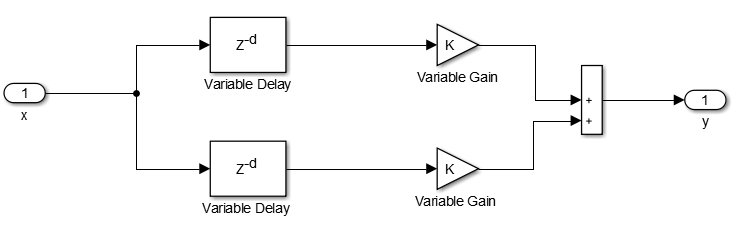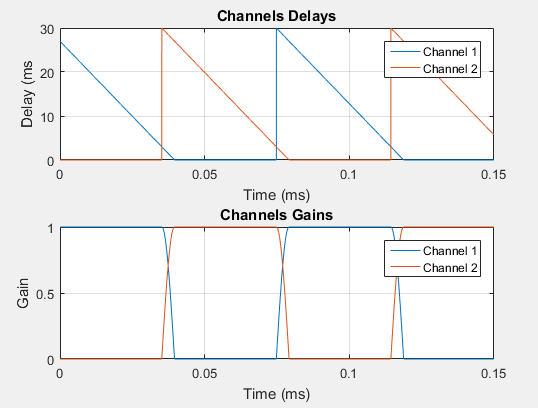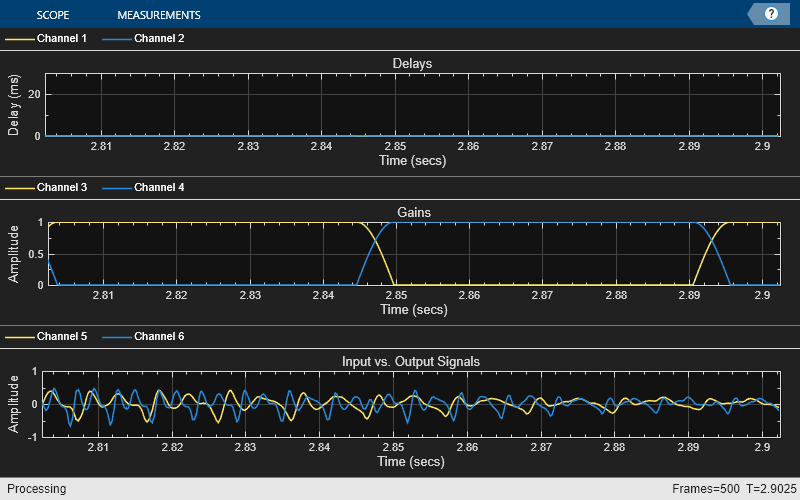Delay-Based Pitch Shifter
This example shows an audio plugin designed to shift the pitch of a sound in real time.
Algorithm
The figure below illustrates the pitch shifting algorithm.

The algorithm is based on cross-fading between two channels with time-varying delays and gains. This method takes advantage of the pitch-shift Doppler effect that occurs as a signal's delay is increased or decreased.
The figure below illustrates the variation of channel delays and gains for an upward pitch shift scenario: The delay of channel 1 decreases at a fixed rate from its maximum value (in this example, 30 ms). Since the gain of channel 2 is initially equal to zero, it does not contribute to the output. As the delay of channel 1 approaches zero, the delay of channel 2 starts decreasing down from 30 ms. In this cross-fading region, the gains of the two channels are adjusted to preserve the output power level. Channel 1 is completely faded out by the time its delay reaches zero. The process is then repeated, going back and forth between the two channels.

For a downward pitch effect, the delays are increased from zero to the maximum value.
The desired output pitch may be controlled by varying the rate of change of the channel delays. Cross-fading reduces the audible glitches that occur during the transition between channels. However, if cross-fading happens over too long a time, the repetitions present in the overlap area may create spurious modulation and comb-filtering effects.
Pitch Shifter Audio Plugin
audiopluginexample.PitchShifter is an audio plugin object that implements the delay-based pitch shifting algorithm. The plugin parameters are the pitch shift (in semi-tones), and the cross-fading factor (which controls the overlap between the two delay branches). You can incorporate the object into a MATLAB® simulation, or use it to generate an audio plugin using generateAudioPlugin.
In addition to the output audio signal, the object returns two extra outputs, corresponding to the delays and gains of the two channels, respectively.
You can open a test bench for audiopluginexample.PitchShifter by using Audio Test Bench. The test bench provides a user interface (UI) to help you test your audio plugin in MATLAB. You can tune the plugin parameters as the test bench is executing. You can also open a dsp.TimeScope and a spectrumAnalyzer to view and compare the input and output signals in the time and frequency domains, respectively.
You can also use audiopluginexample.PitchShifter in MATLAB just as you would use any other MATLAB object. You can use the configureMIDI command to enable tuning the object via a MIDI device. This is particularly useful if the object is part of a streaming MATLAB simulation where the command window is not free.
runPitchShift is a simple function that may be used to perform pitch shifting as part of a larger MATLAB simulation. The function instantiates an audiopluginexample.PitchShifter plugin, and uses the setSampleRate method to set its sampling rate to the input argument Fs. The plugin's parameter's are tuned by setting their values to the input arguments pitch and overlap, respectively. Note that it is also possible to generate a MEX file from this function using the codegen command. Performance is improved in this mode without compromising the ability to tune parameters.
MATLAB Simulation
audioPitchShifterExampleApp implements a real-time pitch shifting app.
Execute audioPitchShifterExampleApp to open the app. In addition to playing the pitch-shifted output audio, the app plots the time-varying channel delays and gains, as well as the input and output signals.

audioPitchShifterExampleApp opens a UI designed to interact with the simulation. The UI allows you to tune the parameters of the pitch shifting algorithm, and the results are reflected in the simulation instantly. The plots reflects your changes as you tune these parameters. For more information on the UI, call help HelperCreateParamTuningUI.
audioPitchShifterExampleApp wraps around HelperPitchShifterSim and iteratively calls it. HelperPitchShifterSim instantiates, initializes and steps through the objects forming the algorithm.
MATLAB Coder™ can be used to generate C code for HelperPitchShifterSim. In order to generate a MEX file for your platform, execute HelperPitchShifterCodeGeneration from a folder with write permissions.
By calling audioPitchShifterExampleApp with 'true' as an argument, the generated MEX file HelperPitchShifterSimMEX can be used instead of HelperPitchShifterSim for the simulation. In this scenario, the UI is still running inside the MATLAB environment, but the main processing algorithm is being performed by a MEX file. Performance is improved in this mode without compromising the ability to tune parameters.
Call audioPitchShifterExampleApp with 'true' as argument to use the MEX file for simulation. Again, the simulation runs till the user explicitly stops it from the UI.
References
[1] 'Using Multiple Processors for Real-Time Audio Effects', Bogdanowicz, K. ; Belcher, R; AES - May 1989.
[2] 'A Detailed Analysis of a Time-Domain Formant-Corrected Pitch-Shifting Algorithm', Bristow-Johnson, R. ; AES - October 1993.